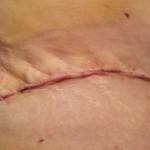Mini abdominoplasty before and after
Mini vs. full abdominoplasty
A combination of a pregnancy and significant weight loss probably would suggest that a full abdominoplasty is the better procedure for you.
Extra skin and laxity above and below the umbilicus could best be firmed up and contoured when the imbrication of muscles above and below the umbilicus is performed.
Excess skin needs to be removed more aggressively than what a mini abdominoplasty could accomplish. Your Plastic Surgeon would be best to answer this question for you after a full consultation. (Francis (Frank) William Rieger, MD, Tampa Plastic Surgeon)
Weight Loss before abdominoplasty
It’s fine to lose down ro your goal weight before surgery if it is going to make your results better. But the only way to know whether that’s the case or not is to see a surgeon and have an evaluation.
Also, don’t tie yourself into a mini tuck without a good consutation with an experienced plastic surgeon. In my experience, there is no shortcut to a good result. Most, but not all, women would get a much better looking abdomen after pregnancy with the standard full abdominoplasty. (Ronald V. DeMars, MD, Portland Plastic Surgeon)
Full or mini abdominoplasty after weight loss
I recommend that you lose the weight that you want to lose. When your weight has stabilized for six months, see a plastic surgeon who can help you decide if you need a full abdominoplasty or a mini. (J. Jason Wendel, MD, FACS, Nashville Plastic Surgeon)
It all depends on your exam…
Many ladies come in seeking a mini-abdominoplasty when in truth they really would most benefit from a full abdominoplasty. The two procedures are quite different. The mini-abdominoplasty while limiting the length of the incision and thus the resultant permanent scar also limits the amount of skin that can be removed. It also limits the amount of muscle tightening. If you have stretch marks or loose skin that is located more than on the lower 50% of the area between the umbilicus and the pubic hair line, one generally needs a full abdominoplasty. If muscle laxity is present above the umbilicus one generally needs a full abdominoplasty. The best advice would be to go meet with a board certified plastic surgeon in your area so that you can learn about the differences between these two operations as well as having a consultation which allows for a recommendation based on your physical exam. (Evan Sorokin, MD, Cherry Hill Plastic Surgeon)
Mini abdominoplasty After Pregnancy
Although I have not had the benefit of examining you, based on your history of pregnancy and weight gain/loss, I think you will likely be a better candidate for a full abdominoplasty as opposed to a mini tummy tuck. A few words of caution for patients contemplating abdominoplasty surgery may be in order: In my opinion, the mini abdominoplasty is an operation that produces very limited results and is very rarely indicated.
It involves a shorter incision but does not address the majority of the abdominal wall issues present for most patients who present consultation. For example, the area of skin excised is quite small. The abdominal wall musculature is addressed below the umbilicus leaving the upper number wall potentially lax.
- Mini abdominoplasty before and after (1)
- Mini abdominoplasty before and after (2)
- Mini abdominoplasty before and after (3)
- Mini abdominoplasty before and after (4)
- Mini abdominoplasty before and after (5)
- Mini abdominoplasty before and after (6)
- Mini abdominoplasty before and after (7)
- Mini abdominoplasty before and after (8)
- Mini abdominoplasty before and after (9)
- Mini abdominoplasty before and after (10)
- Mini abdominoplasty before and after (11)
- Mini abdominoplasty before and after (12)
- Mini abdominoplasty before and after (13)
- Mini abdominoplasty before and after (14)
- Mini abdominoplasty before and after (15)
- Mini abdominoplasty before and after (16)
- Mini abdominoplasty before and after (17)
- Mini abdominoplasty before and after (18)
- Mini abdominoplasty before and after (19)
- Mini abdominoplasty before and after (20)
- Mini abdominoplasty before and after (21)
- Mini abdominoplasty before and after (22)
- Mini abdominoplasty before and after (23)
- Mini abdominoplasty before and after (24)
- Mini abdominoplasty before and after (25)
- Mini abdominoplasty before and after (26)
- Mini abdominoplasty before and after (27)
- Mini abdominoplasty before and after (28)
- Mini abdominoplasty before and after (29)
- Mini abdominoplasty before and after (30)
- Mini abdominoplasty before and after (31)
- Mini abdominoplasty before and after (32)
- Mini abdominoplasty before and after (33)
- Mini abdominoplasty before and after (34)
- Mini abdominoplasty before and after (35)
- Mini abdominoplasty before and after (36)
- Mini abdominoplasty before and after (37)
- Mini abdominoplasty before and after (38)
- Mini abdominoplasty before and after (39)
- Mini abdominoplasty before and after (40)
- Mini abdominoplasty before and after (41)
- Mini abdominoplasty before and after (42)
- Mini abdominoplasty before and after (43)
- Mini abdominoplasty before and after (44)
- Mini abdominoplasty before and after (45)
- Mini abdominoplasty before and after (46)
- Mini abdominoplasty before and after (47)
- Mini abdominoplasty before and after (48)
- Mini abdominoplasty before and after (49)
- Mini abdominoplasty before and after (50)
- Mini abdominoplasty before and after gallery of pictures
- Mini abdominoplasty before and after gallery patients
- Mini abdominoplasty before and after gallery
- Mini abdominoplasty before and after images and photos
- Mini abdominoplasty before and after images
- Mini abdominoplasty before and after of best surgeons
- Mini abdominoplasty before and after on line
- Mini abdominoplasty before and after online
- Mini abdominoplasty before and after photos and images
- Mini abdominoplasty before and after photos of scars
- Mini abdominoplasty before and after photos online
- Mini abdominoplasty before and after photos
- Mini abdominoplasty before and after pictures and images
- Mini abdominoplasty before and after pictures
- Mini abdominoplasty before and after procedure surgery
- Mini abdominoplasty before and after recovery after surgery
- Mini abdominoplasty before and after recovery
- Mini abdominoplasty before and after scar strips
- Mini abdominoplasty before and after see photos
- Mini abdominoplasty before and after stretch marks
- Mini abdominoplasty before and after top cosmetic plastic surgeons
- Mini abdominoplasty before and after top surgeons
- Mini abdominoplasty before and after tummy tuck
- Mini abdominoplasty operation before and after
- Mini abdominoplasty procedure before and after
- Mini abdominoplasty scar before and after image
- Mini abdominoplasty surgeries before and after
- Mini abdominoplasty surgery before and after
- Mini tummy tuck abdominoplasty before and after
- The mini abdominoplasty before and after
The appearance of the umbilicus is not necessarily addressed sufficiently. For most patients who have had pregnancies and/or weight loss a full abdominoplasty is necessary to achieve the desired results. Of course, there are downsides (including a longer scar and probably a longer recovery time) but for most patients the benefits outweigh the downsides. It is not unusual to see patients who’ve had mini abdominoplasty surgery present for revisionary surgery. It is important for patients seeking abdominal contouring surgery to work with a well experienced board-certified plastic surgeon to obtain advice (based on good ethics and judgment) to improve their chances of a successful outcome and minimize the need for further surgery. (Tom J. Pousti, MD, FACS, San Diego Plastic Surgeon)
























































































